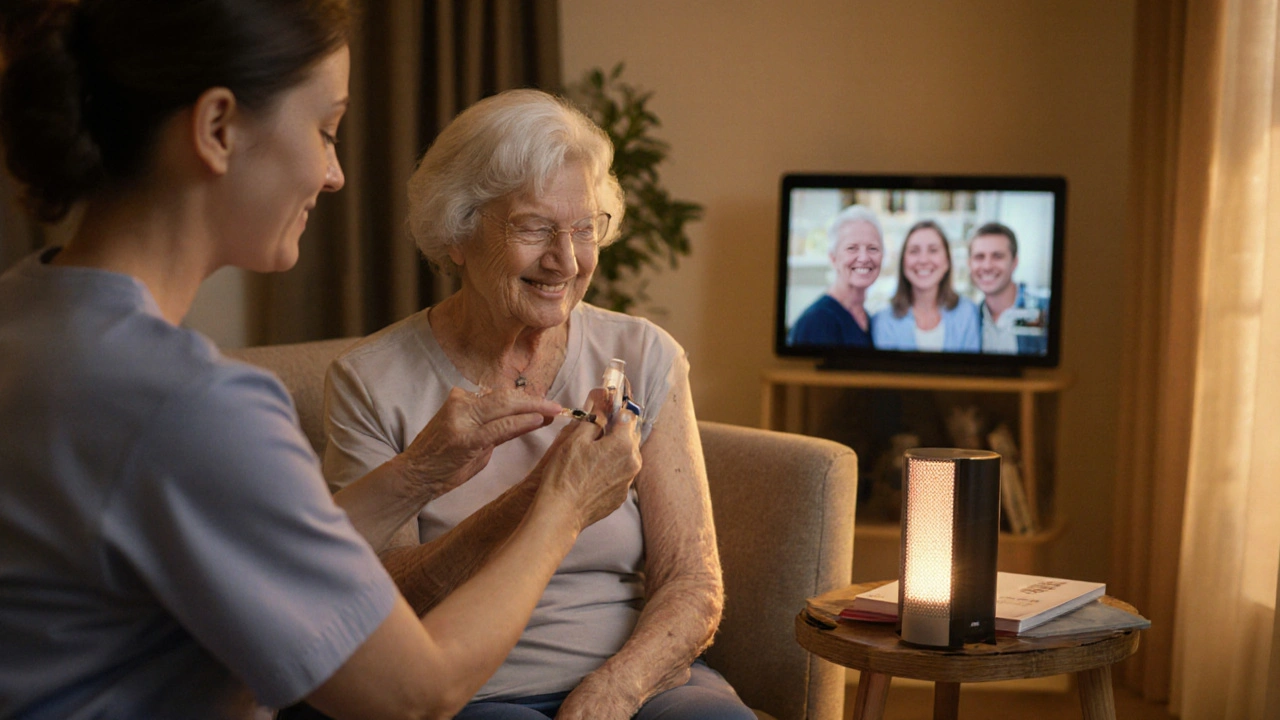HIV Risk Assessment for Older Adults
This tool helps assess potential health risks associated with HIV in older adults based on key factors.
Risk Assessment Result
When a person over 50 lives with AIDS a condition caused by the human immunodeficiency virus that attacks the immune system, the experience looks different from that of a younger patient. The combination of age‑related changes and the virus creates a unique set of medical, emotional, and social hurdles. Below we break down what those challenges are, why they matter, and how older adults, families, and clinicians can address them.
Why HIV Looks Different in Older Adults
Age brings natural shifts in the body’s defenses, a process known as immunosenescence the gradual decline of immune function that makes infections harder to fight. When HIV adds its own assault, the result is a double hit. Studies from 2023 show that people over 55 with HIV have a 30% higher risk of opportunistic infections than younger peers on the same treatment.
Another layer is comorbidities additional chronic diseases such as heart disease, diabetes, or osteoporosis that often coexist with HIV. These conditions multiply medication loads and can interfere with the effectiveness of antiretroviral therapy (ART) the drug regimen that suppresses HIV replication and restores immune health. The interaction between ART and drugs for hypertension, for example, can raise the risk of kidney problems if not monitored closely.
Medical Challenges Unique to Seniors
- Reduced Immune Recovery: Even with optimal ART, CD4 counts may climb slower in older adults, leaving them vulnerable longer.
- Polypharmacy: Managing more than five medications is common. Overlapping side‑effects can cause fatigue, dizziness, or liver strain.
- Cardiovascular Risk: HIV‑related inflammation, plus age, accelerates atherosclerosis. Regular lipid panels and blood pressure checks become vital.
- Bone Health: Tenofovir, a popular ART component, can lower bone mineral density. Seniors need bone‑density scans and calcium‑vitamin D supplementation.
- Neurocognitive Decline: HIV‑associated neurocognitive disorder (HAND) can masquerade as early dementia, complicating diagnosis.
These points illustrate the need for a coordinated care model where a HIV specialist, primary doctor, pharmacist, and often a geriatrician communicate regularly.
Social and Emotional Hurdles
The stigma negative attitudes and discrimination faced by people living with HIV doesn’t fade with age. Older adults may worry about disclosing their status to adult children or new partners, fearing judgment or isolation. A 2022 Australian survey found that 48% of people over 60 with HIV felt they received less social support than younger patients.
Loneliness compounds the problem. Retirement, loss of a spouse, or reduced mobility already increase the risk of depression; adding HIV can double that risk. Mental‑health services tailored to seniors-such as counseling that respects both age‑related concerns and HIV‑related anxiety-are still scarce.

Access to Age‑Friendly Healthcare
Many clinics specialize in HIV but lack facilities for older patients. Wheelchair access, hearing‑friendly communication, and flexible appointment times are often missing. Telehealth has helped during the pandemic, yet older adults may lack reliable internet or comfort with video calls.
Insurance coverage is another puzzle. In Australia, the Medicare Benefits Schedule (MBS) covers ART, but ancillary services-like physiotherapy for bone health or geriatric cognitive assessments-may require out‑of‑pocket spending, deterring regular visits.
Practical Strategies for Managing HIV in Later Life
- Regular Comprehensive Reviews: Schedule a full health check every six months that includes CD4 count, viral load, lipid profile, kidney function, and bone density.
- Medication Reconciliation: Have a pharmacist review all prescriptions to spot interactions, especially between ART and blood‑pressure meds.
- Tailored ART Regimens: Prefer newer integrase‑strand inhibitors that have fewer side‑effects and less impact on bone health.
- Vaccination Boost: Get flu, COVID‑19, pneumococcal, and shingles vaccines-critical for a weakened immune system.
- Nutrition and Exercise: A balanced diet rich in protein, calcium, and vitamin D, paired with weight‑bearing exercise, helps combat muscle loss and bone fragility.
- Mental‑Health Support: Join peer groups for seniors living with HIV, and consider therapy that addresses both age‑related loss and HIV‑specific stress.
- Community Resources: Many NGOs offer transportation assistance, home‑visit nursing, and legal advice for older adults with chronic illnesses.
These steps create a safety net that reduces hospitalizations and improves quality of life.
Comparison of Key Issues: Younger vs. Older HIV Patients
| Aspect | Younger Adults (18‑44) | Older Adults (55+) |
|---|---|---|
| Immune Recovery (CD4 rise) | Fast, often >200 cells/µL in 6months | Slower, may plateau below optimal levels |
| Comorbidity Burden | Low to moderate | High - cardiovascular, metabolic, bone disease |
| Polypharmacy Risk | Rare | Common - >5 meds |
| Stigma Impact | Social media‑driven, peer pressure | Age‑related shame, fear of family judgment |
| Healthcare Navigation | Typically via specialized HIV clinics | Needs integration with geriatric services |

How Caregivers and Families Can Help
Family members often become informal case managers. Simple actions-like keeping a medication calendar, accompanying to doctor visits, or checking in on mental health-make a huge difference. Encourage open conversations about the diagnosis; this reduces secrecy and builds a support network.
Educate yourself about HIV the virus that causes AIDS and requires lifelong treatment basics, so you can spot side‑effects early. Many community health centers offer caregiver workshops that cover legal rights, advance directives, and financial planning for chronic illness.
Future Directions: What’s on the Horizon?
Research into long‑acting injectable ART is promising for seniors who struggle with daily pill burdens. A 2024 trial showed that a bi‑monthly injection kept viral loads suppressed in 92% of participants over 60, with fewer drug‑interaction concerns.
Another emerging field is “geriatric HIV care models” that embed HIV specialists in primary‑care practices focused on older patients. Early pilots in Melbourne report a 25% reduction in hospital admissions for HIV‑related complications.
Finally, digital health tools that use voice‑activated reminders are gaining traction, helping those with visual impairments or arthritic hands stay on schedule.
Frequently Asked Questions
Can older adults achieve undetectable viral loads?
Yes. With modern ART, most seniors can reach and maintain an undetectable level, though it may take longer than in younger patients. Consistent monitoring and addressing drug interactions are key.
What are the biggest drug‑interaction risks for seniors on ART?
Common culprits include statins, certain blood‑pressure meds, and some over‑the‑counter pain relievers. A pharmacist‑led review at least annually can catch hazardous combinations.
How does stigma affect mental health in older HIV patients?
Stigma can lead to isolation, non‑adherence, and depression. Seniors may hide their status from family, missing out on support. Peer‑support groups and counseling that address both age‑related and HIV‑related concerns improve outcomes.
Are there specific vaccines older adults with HIV should prioritize?
Flu, COVID‑19, pneumococcal, and shingles vaccines are strongly recommended. Because the immune system is compromised, timing the vaccines when the viral load is stable yields better protection.
What lifestyle changes help older adults manage HIV?
Regular aerobic exercise, a diet rich in fruits, vegetables, lean protein, and calcium, adequate sleep, and smoking cessation all support immune health and reduce comorbidity risk.



Narayan Iyer
Yo fam, gotta shout out how essential it is to merge geriatric gerontology wit HIV care – the combo can totally level up outcomes. Polypharmacy is a beast, so we need cross‑disciplinary teams talkin’ meds like protease inhibitors and statins in the same room. Data shows seniors on ART still face virologic blips when drug‑drug interactions slip thru the cracks. Bridging primary care docs with infectious disease specialists can catch those pitfalls early. Also, stigma ain’t just a buzzword; it actually hampers adherence when folks hide their status. Community health centers that host support circles for older adults can chop that stigma down. Tech like voice‑activated reminders helps when arthritic hands struggle with pillboxes. Bottom line: integrated care models + robust education = better quality of life for our aging HIV‑positive tribe.